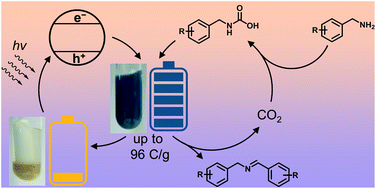Fresh IDEAS in photocatalysis
Published in Chemistry

Before I actually explain why I wrote 'IDEAS' in the title using all capital letters, I need to give a brief introduction to our fresh article 'Green radicals of potassium poly(heptazine imide) using light and benzylamine' in the Journal of Materials Chemistry A. It is available as an open access publication via the link.
Certain conjugated molecules can form persistent tinted radicals. Such radicals, under certain conditions, for example, strictly in the oxygen-free environment, can exist long enough to be easily detected by the naked eye.
Ketyl radical is one example of such specie. It is generated by one-electron reduction of benzophenone with sodium metal. It has saturated blue colour. Due to high reactivity toward oxygen and water, it is used as a desiccant to remove traces of moisture and O2 from organic solvents. It is easy! When mixed with the solvent, blue colour means the solvent is dry and free of O2, colourless – contains moisture and/or O2.
Methylviologen radical is another example of stable tinted radicals. Due to intense blue colour it is used as a redox indicator, while its extinction coefficient reaches 13900 M-1 cm-1 and was determined by Dr. Watanabe and Dr. Honda back in 1982.
Many small molecules can form persistent tinted radicals. But how about conjugated polymers?
Several teams, including Prof. Bettina Lotsch's group at Ludwig Maximilian University of Munich, Prof. Erwin Reisner's group in Cambridge and mine at the Max Planck Institute of Colloids and Interfaces in Potsdam, are actively working on polymeric carbon nitride materials. It has been discovered that poly(heptazine imide), a type of carbon nitride material, can form persistent radical. Similarly to ketyl and methylviologen radicals, poly(heptazine imide) radical has rich green or blue colour.
It is relatively easy to measure concentration of persistent tinted small organic radicals in solution, i. e. methyl viologen, using absorption spectroscopy, but difficult for organic semiconductors. Namely, we are interested to know how many electrons are there in 1 g of the organic semiconductor. One electron per a repeating unit, one per ten repeating units or maybe one per hundred repeating units?
We developed a method to measure the number of electrons trapped in 1 g of poly(heptazine imide). The method is based on titration of green poly(heptazine imide) radical with methylviologen dichloride. Details are not the main point of this Chemistry Community article, but may be found via the link. The point is different.
I have been always amazed by the ingenious acronyms devised by scientists. Here are several examples of such acronyms. In the nuclear magnetic resonance spectroscopy: COSY – COrrelated SpectroscopY (and also adjective), INADEQUATE – Incredible Natural Abundance DoublE QUAntum Transfer Experiment, 2D ADEQUATE – Adequate DoublE QUAntum Transfer Experiment. Chemical name: TEMPO – 2,2,6,6-TEtraMethylPiperidin-1-yl)Oxyl. In polymer chemistry: CROP – Cationic Ring-Opening Polymerization. I am sure there are much more. Write more smart chemical/physical acronyms in the comments! I would really like to know more of them.
Anyway, after we have prepared a draft of the paper, we simply could not miss a chance to design a witty acronym for this vivid process – formation of green poly(heptazine imide) radical. So here it is ‘IDEAS’ – Illumination Driven Electrons Accumulation in Semiconductor.
The feature of poly(heptazine imide) to store electrons had already found some interesting uses that we have just recently summarized in the review, but it may also give some fresh ideas in photocatalysis.






Please sign in or register for FREE
If you are a registered user on Research Communities by Springer Nature, please sign in
I find LOV and BLUF acronyms in photoreceptors' names quite peculiar. LOV stands for light-oxygen-voltage and BLUF - for blue-light utilising FAD, they are particularly amusing because they are often used next to each other in one sentence in reviews introducing biological photosensors, and they even somewhat rhyme!
Also, talking about interesting names, although not acronyms, I like the story of Western, Northern and Southern blotting used in molecular/cell biology. The first technique of the three was called after its inventor, Edwin Southern, and was used for DNA detection, while the other two invented later (protein and RNA blotting) were called "western' and "northern" out of similarity and, I believe, for fun :)